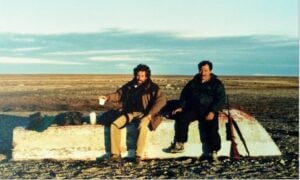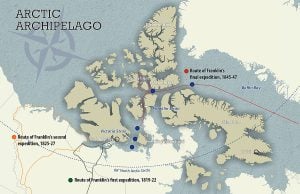
People & Culture
On thin ice: Who “owns” the Arctic?
As the climate heats up, so do talks over land ownership in the Arctic. What does Canadian Arctic Sovereignty look like as the ice melts?
- 4353 words
- 18 minutes
This article is over 5 years old and may contain outdated information.
Exploration

HMS Terror, the second of Sir John Franklin’s two ships that were lost in the Canadian Arctic 168 years ago, has been located in an uncharted bay in Nunavut, according to an exclusive report in the Guardian.
The ship, which was found in King William Island’s Terror Bay on Sept. 3 by crew members of the Arctic Research Foundation, is in “pristine condition” and under about 24 metres of water, the report says.
Adrian Schimnowski, operations director for the foundation, told the Guardian that a remotely-operated vehicle had already been inside Terror.
“We have successfully entered the mess hall, worked our way into a few cabins and found the food storage room with plates and one can on the shelves,” Schimnowski said in an email to the newspaper. “We spotted two wine bottles, tables and empty shelving. Found a desk with open drawers with something in the back corner of the drawer.”
The find comes almost exactly two years after Parks Canada located HMS Erebus, Terror’s sister ship, and is already being hailed by those familiar with the Franklin story as a major step in helping solve the mystery of what happened during the ill-fated 1845-1848 expedition.
“My mind is reeling,” said Dave Woodman, who has spent years investigating and writing about the importance of Inuit oral tradition and testimony in determining Franklin’s fate. “It sounds like Terror is the wreck of my dreams from when I was a young diver. But every time you get a piece of the Franklin puzzle, you have to reconstruct it, so that’s what we have to do now.”
“The well-preserved wreck matches the Terror in several key aspects,” the Guardian states, “but it lies 60 miles (96km) south of where experts have long believed the ship was crushed by ice, and the discovery may force historians to rewrite a chapter in the history of exploration.” The Guardian noted that “A long, heavy rope line running through a hole in the ship’s deck suggests an anchor line may have been deployed before the Terror went down. If true, that sets up the tantalising possibility that British sailors re-manned the vessel after she was abandoned at the top of Victoria Strait in a desperate attempt to escape south.”
“Just like Erebus, it’s validating of Inuit testimony — it’s near the shore, it’s in a bay — and it’s almost impossible to conclude that the ice took it there,” said Woodman of the possibility of the ship having been anchored.
The Guardian details that Sammy Kogvik, an Inuk from Gjoa Haven who was aboard the Arctic Research Foundation’s research vessel Martin Bergmann as a crewmember, played a key role in the discovery when he told Schimnowski that about six years ago, he and a friend had spotted what looked like a mast sticking out of sea ice covering Terror Bay.
“In a phone interview,” the Guardian says, “Kogvik said he stopped that day to get a few snapshots of himself hugging the wooden object, only to discover when he got home that the camera had fallen out his pocket. Kogvik resolved to keep the encounter secret, fearing the missing camera was an omen of bad spirits, which generations of Inuit have believed began to wander King William Island after Franklin and his men perished. When Schimnowski heard Kogvik’s story, he didn’t dismiss it, as Inuit testimony has been so often during the long search for Franklin’s ships. Instead, the Bergmann’s crew agreed to make a detour for Terror Bay on their way to join the main search group aboard the Canadian Coast Guard icebreaker CCGS Sir Wilfrid Laurier and the Royal Canadian Navy’s HMCS Shawinigan, at the north end of Victoria Strait.”
“Great news about Sammy Kogvik — perfect symmetry of history,” said Franklin historian and author Russell Potter in an email to Canadian Geographic. In a blog story he posted today, Potter said “All the Inuit I know on King William Island have hoped, over many years, for a find like this, not simply because it would vindicate their ancestors’ stories or bring media attention — but because it would bring economic growth, which is so sorely lacking in the North.”
In the same post, Potter also expressed delight at the apparent state of Terror. “Initial images show her to be in far better condition than her sister ship, the “Erebus” … with her hatches battened, her bowsprit still in place, and many of the glass panes in her captain’s cabin still intact. It’s enough to warm the heart of any marine archaeologist — or perhaps give them a heart attack! — certainly a discovery that exceeds anyone’s (mine included) wildest imaginings as to the vessel’s state of preservation.”
Are you passionate about Canadian geography?
You can support Canadian Geographic in 3 ways:

People & Culture
As the climate heats up, so do talks over land ownership in the Arctic. What does Canadian Arctic Sovereignty look like as the ice melts?

History
Arctic historian Ken McGoogan takes an in-depth, contemporary perspective on the legacy of Sir John Franklin, offering a new explanation of the famous Northern mystery

Exploration
Parks Canada’s Underwater Archaeology Team is planning a reconnaissance mission of the HMS Erebus and will continue its search for HMS Terror at the end of August

History
Our experts dissect the debut episodes of AMC’s new series about the Franklin Expedition